An Optimal Combination of the Propagation Medium and Fogging Duration Enhances the Survival, Rooting and Early Growth of Strawberry Daughter Plants
Abstract
1. Introduction
2. Materials and Methods
2.1. The Experiment Locations and Experimental Conditions
2.2. Plant Materials and Propagation Media
2.3. Fogging System and Experimental Design
2.4. Measurements of the Growth Parameters
2.5. Measurement of Hydrogen Peroxide
2.6. Measurement of Activities of Antioxidant Enzymes
2.7. Statistical Analysis
3. Results
3.1. Survival Percentage
3.2. Percentage of Rooting and Ratio of Newly-Grown Leaves
3.3. Growth Parameters
3.4. Plants Morphology
3.5. Hydrogen Peroxide Content and Activities of Antioxidant Enzymes
4. Discussion
5. Conclusions
Author Contributions
Funding
Acknowledgments
Conflicts of Interest
References
- Korea Agro-Fisheries & Food Trade Corporation. 2017. Available online: http://www.at.or.kr/article/apko361000/list.action (accessed on 7 March 2020).
- Husaini, A.M.; Neri, D. (Eds.) Strawberry: Growth, Development and Diseases; CABI: Wallingford, UK, 2016. [Google Scholar]
- Durner, E.F.; Poling, E.B.; Maas, J.L. Recent advances in strawberry plug transplant technology. Hort. Technol. 2002, 12, 545–550. [Google Scholar] [CrossRef]
- Poling, E.B.; Maas, J.L. Strawberry plug transplant technology. Acta Hortic. 1998, 513, 393–402. [Google Scholar] [CrossRef]
- Hughes, H. The effects of planting time, runner size and plant spacing on the yield of strawberries. J. Hortic. Sci. 1967, 42, 253–262. [Google Scholar] [CrossRef]
- Freeman, J.A.; Pepin, H.S. Influence of plant size, date of digging and duration of cold storage on the growth of strawberry plants. Can. J. Plant Sci. 1971, 51, 267–274. [Google Scholar] [CrossRef]
- Crawford, T.D.; Himelrick, D.G.; Sibley, J.L.; Pitts, J.A. Effect of runner plantlet size on performance of strawberry plug plants. Small Fruits Rev. 2000, 1, 15–21. [Google Scholar] [CrossRef]
- Rowley, D.; Black, B.; Drost, D. Strawberry Plug Plant Production; Plants, Soils, and Climate Faculty Publications, USU Extension: Logan, UT, USA, 2010; pp. 1–5. [Google Scholar]
- Lieten, F. Short cut strawberry propagation. Grow. 1994, 121, 35. [Google Scholar]
- Treder, W.; Tryngiel-Gac, A.; Klamkowski, K.; Masny, A. Evaluation of efficiency of a nursery system for production of strawberry potted plants in protected conditions. Infrastrukt. Ekol. Teren. Wiej. 2014, 4, 1333–1341. [Google Scholar]
- Peyvast, G.H.; Noorizadeh, M.; Hamidoghli, J.; Ramezani-Kharazi, P. Effect of four different substrates on growth, yield and some fruit quality parameters of cucumber in bag culture. Int. Symp. Grow. Media 2005, 779, 535–540. [Google Scholar]
- Gao, H.B.; Zhang, T.J.; Lv, G.Y.; Zhang, G.H.; Wu, X.L.; Li, J.R.; Gong, B.B. Effects of different compound substrates on growth, yield and fruit quality of cucumber. Int. Symp. Veg. Saf. Hum. Health 2006, 856, 173–180. [Google Scholar] [CrossRef]
- Jiang, M.; Zhang, J. Role of abscisic acid in water stress-induced antioxidant defense in leaves of maize seedlings. Free Radic. Res. 2002, 36, 1001–1015. [Google Scholar] [CrossRef]
- Baisak, R.; Rana, D.; Acharya, P.B.; Kar, M. Alterations in the activities of active oxygen scavenging enzymes of wheat leaves subjected to water stress. Plant Cell Physiol. 1994, 35, 489–495. [Google Scholar]
- Jafarnia, S.; Hatamzadeh, A.; Tehranifar, A. Effect of different substrates and varieties on yield and quality of strawberry in soilless culture. Adv. Environ. Biol. 2010, 4, 325–329. [Google Scholar]
- Giménez, G.; Andriolo, J.L.; Janisch, D.; Godoi, R. Closed soilless growing system for producing strawberry bare root transplants and runner tips. Pesqui. Agropecuária Bras. 2008, 43, 1757–1761. [Google Scholar] [CrossRef]
- Bartczak, M.; Pietrowska, M.; Knaflewski, M. Effects of substrate on vegetative quality of strawberry plants (Fragaria x ananassa Duch.) produced by soilless method. Folia Hortic. 2007, 19, 39–46. [Google Scholar]
- Kim, T.I.; Jang, W.S.; Choi, J.H.; Nam, M.H.; Kim, W.S.; Lee, S.S. Breeding of strawberry ‘Maehyang’ for forcing culture. Hortic. Sci. Technol. 2004, 22, 434–437. [Google Scholar]
- Kim, T.I.; Jang, W.S.; Nam, M.H.; Lee, W.K.; Lee, S.S. Breeding of strawberry ‘Sulhyang’ for forcing culture. IHC 2006, 2006, 231. [Google Scholar]
- Han, K.S.; Kim, S.C.; Lee, Y.B.; Kim, S.C.; Im, D.H.; Choi, H.K.; Hwang, H. Strawberry harvesting robot for bench-type cultivation. J. Biosyst. Eng. 2012, 37, 65–74. [Google Scholar] [CrossRef]
- Christou, A.; Manganaris, G.A.; Fotopoulos, V. Systemic mitigation of salt stress by hydrogen peroxide and sodium nitroprusside in strawberry plants via transcriptional regulation of enzymatic and non-enzymatic antioxidants. Environ. Exp. Bot. 2014, 1074, 6–54. [Google Scholar] [CrossRef]
- Giannopolitis, C.N.; Rios, S.K. Superoxide dismutases: Purification and quantitative relationship and soluble protein in seedlings. Plant Physiol. 1977, 59, 315–318. [Google Scholar] [CrossRef]
- Cakmak, I.; Marschner, H. Magnesium deficiency and high light intensity enhance activities of superoxide dismutase, ascorbate peroxidase, and glutathione reductase in bean leaves. Plant Physiol. 1992, 98, 1222–1227. [Google Scholar] [CrossRef]
- Shah, K.; Kumar, R.G.; Verma, S.; Dubey, R.S. Effect of cadmium on lipid peroxidation, superoxide anion generation and activities of antioxidant enzymes in growing rice seedlings. Plant Sci. 2001, 161, 1135–1144. [Google Scholar] [CrossRef]
- Nakano, Y.; Asada, K. Hydrogen peroxide is scavenged by ascorbate-specific peroxidase in spinach chloroplasts. Plant Cell Physiol. 1981, 22, 867–880. [Google Scholar]
- Bussell, W.; Mckennie, S. Rockwool in horticulture, and its importance and sustainable use in New Zealand. N. Z. J. Crop. Hort. 2004, 32, 29–37. [Google Scholar] [CrossRef]
- Kim, H.M.; Kim, H.M.; Jeong, H.W.; Lee, H.R.; Jeong, B.R.; Kang, N.J.; Hwang, S.J. Growth and rooting rate of ‘Maehyang’ strawberry as affected by irrigation method on cutting propagation in summer season. Prot. Hortic. Plant Fact. 2018, 27, 103–110. [Google Scholar] [CrossRef]
- Okunlola, A.I. The effects of cutting types and length on rooting of Duranta repens in the nursery. Glob. J. Hum. Soc. Sci. Geogr. Geo. Sci. Environ. Disaster Manag. 2003, 13, 1–5. [Google Scholar]
- De Swaef, T.; Verbist, K.; Cornelis, W.; Steppe, K. Tomato sap flow, stem and fruit growth in relation to water availability in rockwool growing medium. Plant Soil 2012, 350, 237–252. [Google Scholar] [CrossRef]
- Choudhury, S.; Panda, P.; Sahoo, L.; Panda, S.K. Reactive oxygen species signaling in plants under abiotic stress. Plant Signal. Behav. 2013, 8, e23681. [Google Scholar] [CrossRef]
- Gratão, P.L.; Polle, A.; Lea, P.J.; Azevedo, R.A. Making the life of heavy metal-stressed plants a little easier. Funct. Plant Biol. 2005, 32, 481–494. [Google Scholar] [CrossRef]
- Hall, A.J.; Connor, D.J.; Whitfield, D.M. Root respiration during grain filling in sunflower: The effects of water stress. Plant Soil 1990, 121, 57–66. [Google Scholar] [CrossRef]
- Liao, C.T.; Lin, C.H. Physiological adaptation of crop plants to flooding stress. Proc. Natl. Sci. Counc. ROC(B) 2001, 25, 148–157. [Google Scholar]
- Gambrell, R.P.; Patrick, W.H. Chemical and microbiological properties of anaerobic soils and sediments. In Plant Life Anaerob. Environ; Hook, D.D., Crawford, R.M.M., Eds.; John Wiley & Sons Ltd.: Collingwood, MI, USA, 1978; pp. 375–423. [Google Scholar]
- Beyl, C.A.; Trigiano, R.N. Plant Propagation Concepts and Laboratory Exercises; CRC Press: Boca Raton, FL, USA, 2011. [Google Scholar]
- Regagba, Z.; Choi, J.M.; Latigui, A.; Mederbal, K.; Latigui, A. Effect of various mg concentrations in nutrient solution on growth and nutrient uptake response of strawberry (Fragaria×ananassa duch.) ’Seolhyang’ grown in soilless culture. J. Biol. Sci. 2014, 14, 226–236. [Google Scholar]
- Takeda, F. Strawberry production in soilless culture systems. Int. Symp. Grow. Media Hydroponics 1997, 19, 289–296. [Google Scholar] [CrossRef]
- Olympios, C.M. Soilless media under protected cultivation rockwool, peat, perlite and other substrates. Acta Hortic. 1992. 323, 215–234. [CrossRef]
- Tehranifar, A.; Poostchi, M.; Arooei, H.; Nematti, H. Effects of seven substrates on qualitative and quantitative characteristics of three strawberry cultivars under soilless culture. In Proceedings of the XXVII International Horticultural Congress-IHC2006: International Symposium on Advances in Environmental Control, Automation, Seoul, Korea, 13–16 August 2006; pp. 485–488. [Google Scholar]
- Gislerød, H.R. Physical conditions of propagation media and their influence on the rooting of cuttings. Plant Soil 1983, 75, 1–14. [Google Scholar] [CrossRef]
- Jun, H.J.; Jun, E.H.; Kang, S.I.; Bae, K.H. Effect of cold treatment for mother plants of new strawberry cultivars bred in Korea on the production of runners and daughter plants. Prot. Hortic. Plant Fact. 2015, 24, 8–12. [Google Scholar] [CrossRef]
- Choi, H.G.; Hwang, M.R.; Choi, K.S.; Kang, N.J. Effect of application of salicylic acid on the plant growth and fruit quality in strawberry. J. Agric. Life Sci. 2018, 52, 11–22. [Google Scholar] [CrossRef]
- Kang, D.I.; Jeong, H.K.; Park, Y.G.; Hwang, S.J.; Jeong, B.R. Effect of nutrient solution strength and duration of nutrient starvation on growth and flowering of two strawberry cultivars. J. Agric. Life Sci. 2019, 53, 19–28. [Google Scholar] [CrossRef]
- Kim, D.Y.; Kim, S.; Kang, Y.I.; Yun, H.K.; Yoon, M.K.; Kim, T.I.; Choi, J.M. Effect of runner cutting time on growth and yield during nursery of strawberry (cv. ‘Maehyang’ and ‘Seolhyang’). Prot. Hortic. Plant Fact. 2012, 21, 385–391. [Google Scholar] [CrossRef]
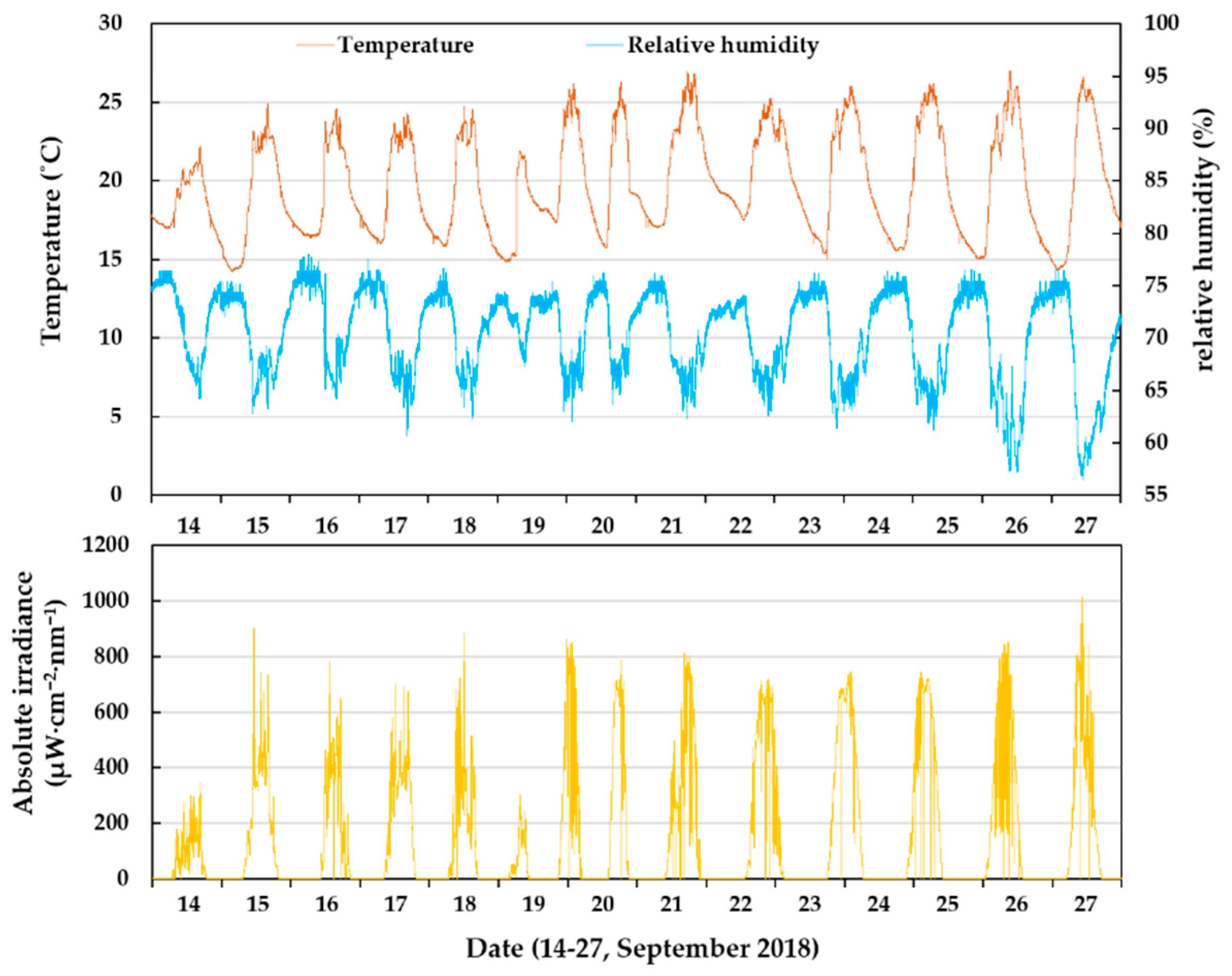
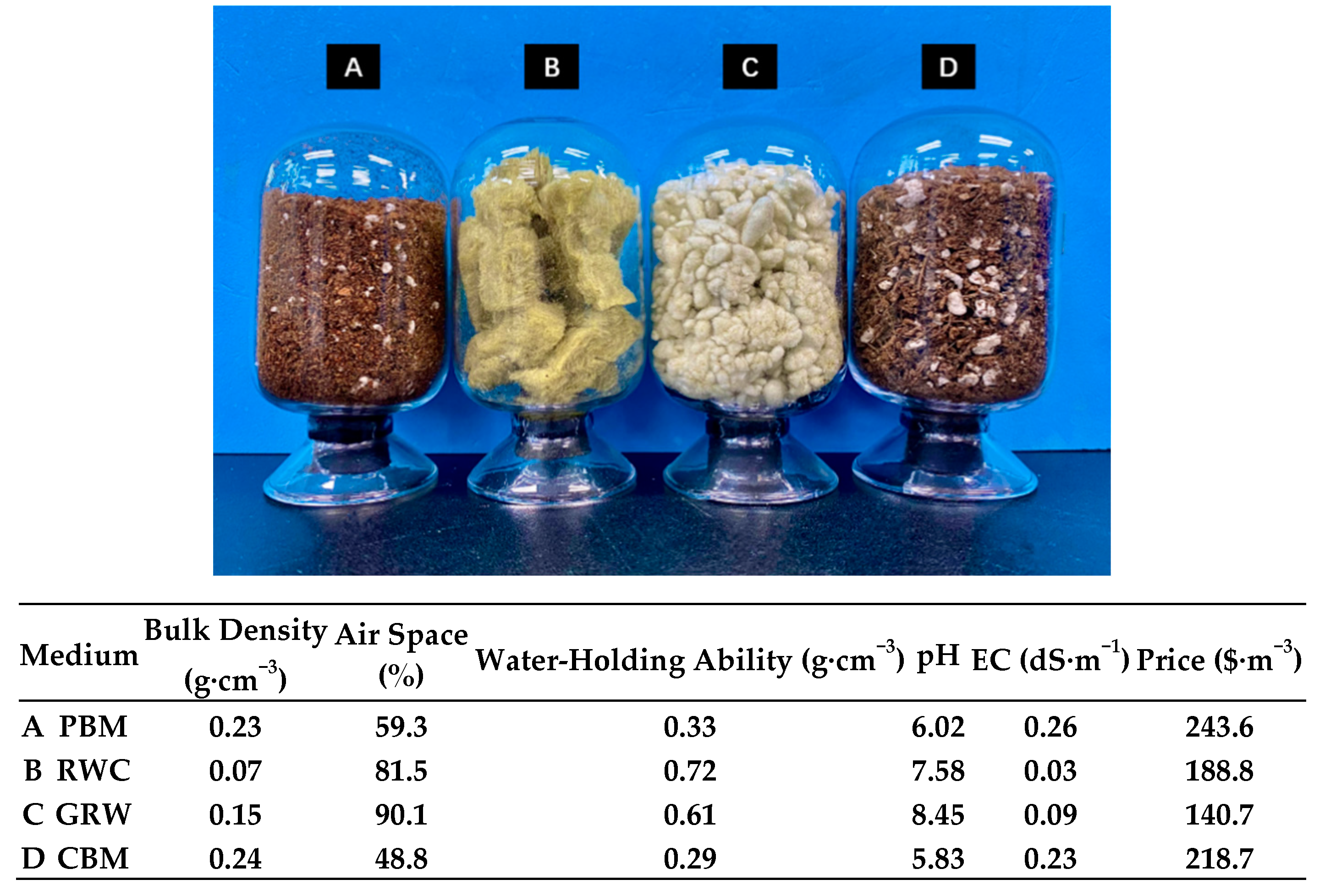
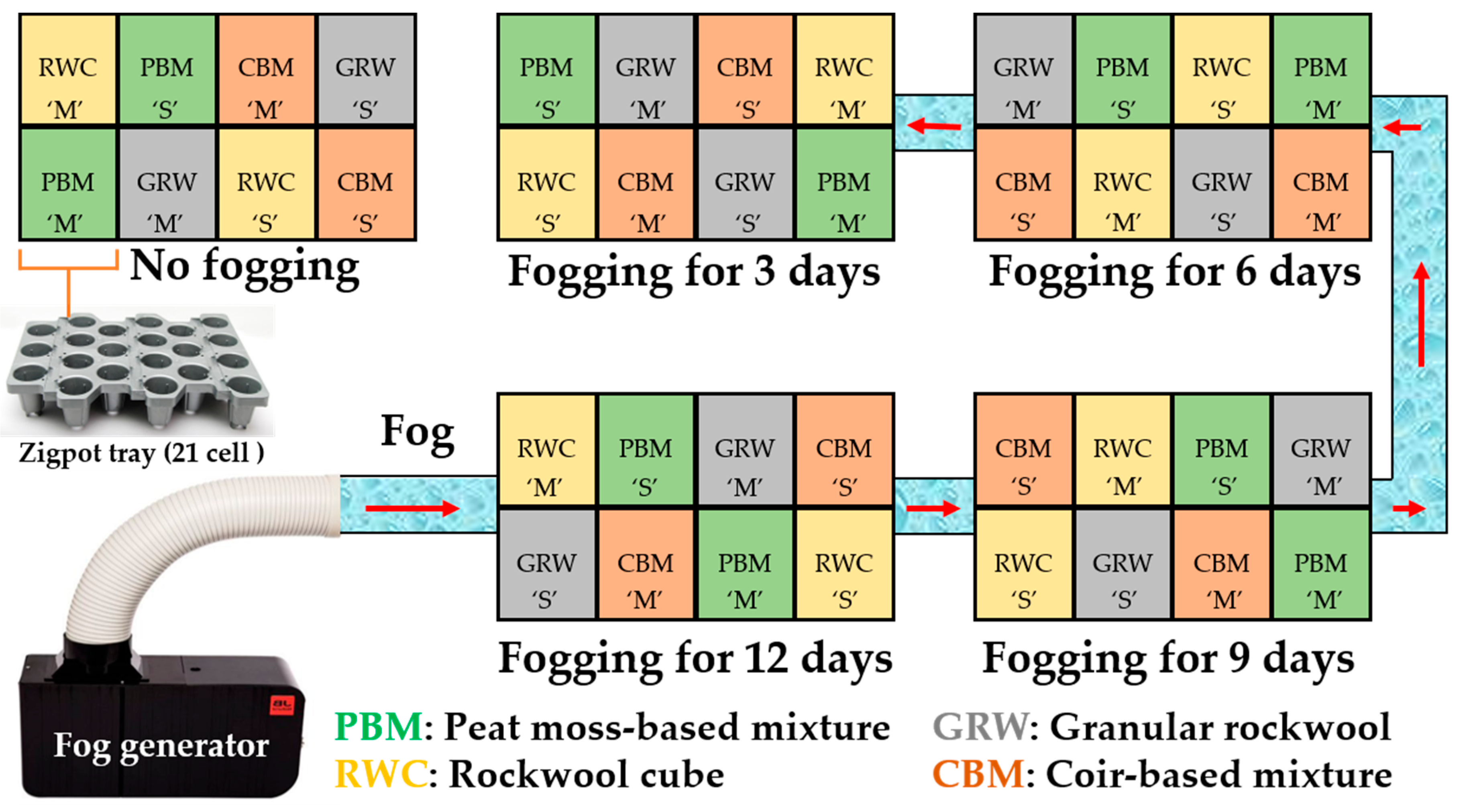
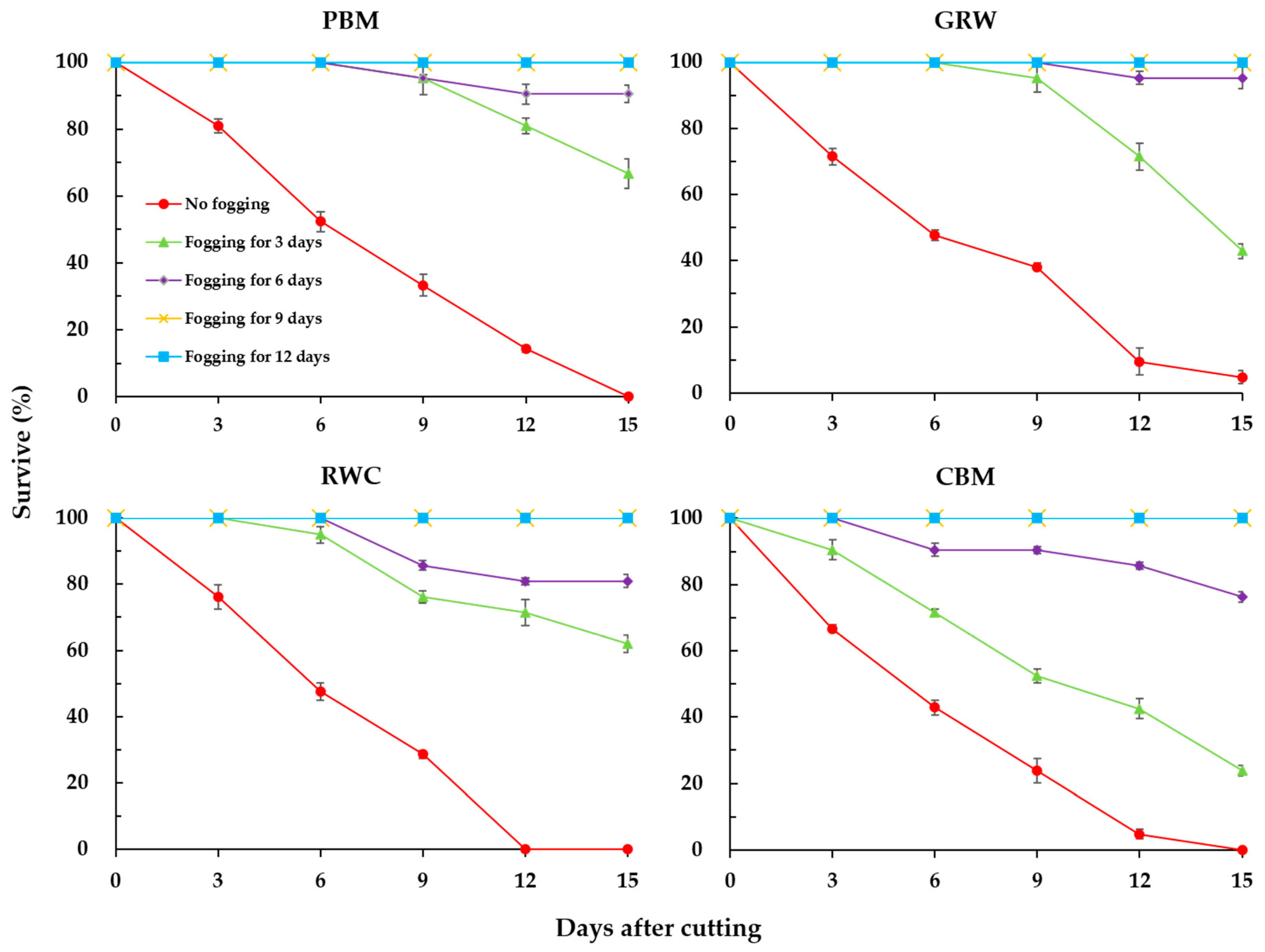
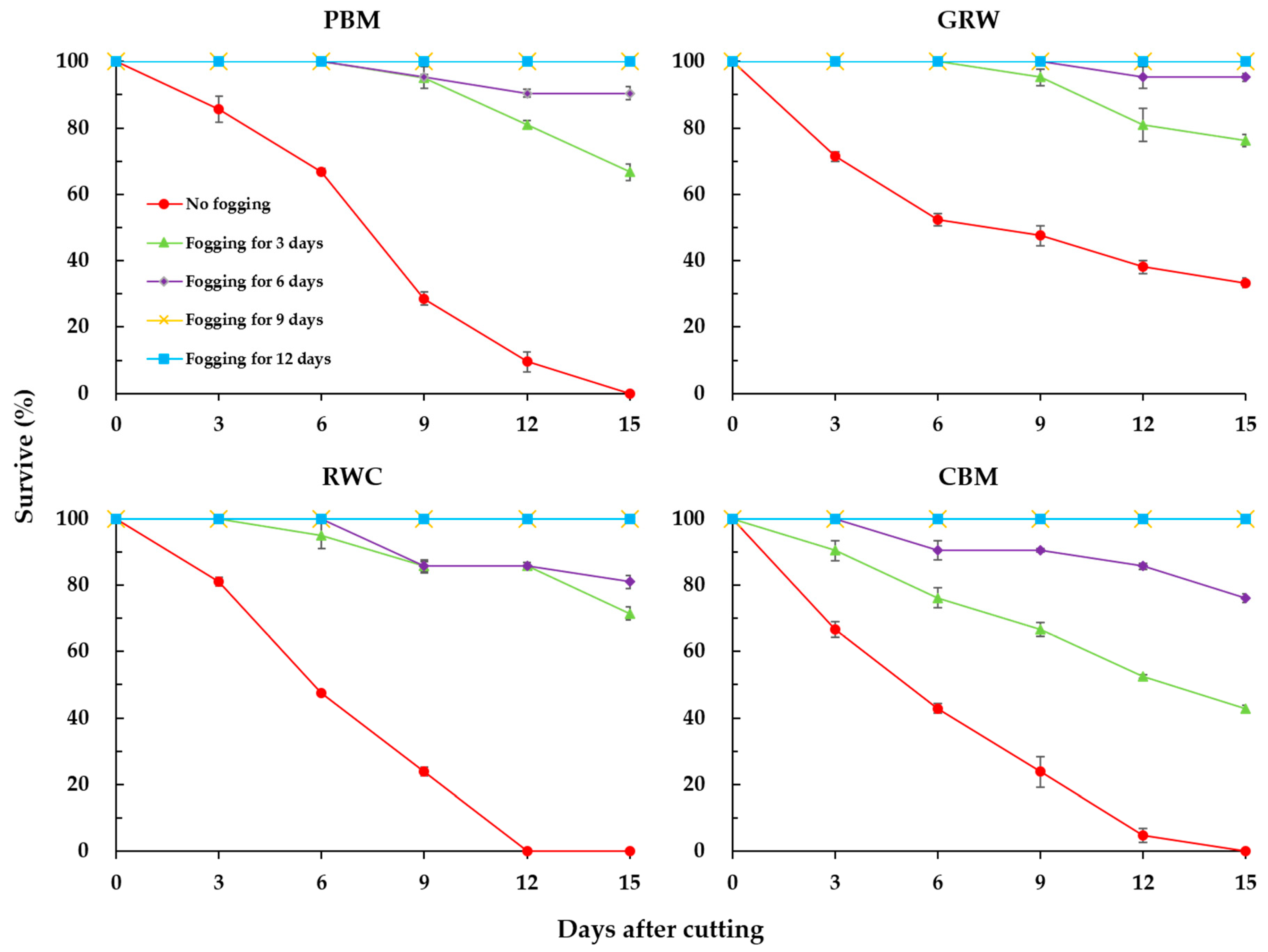


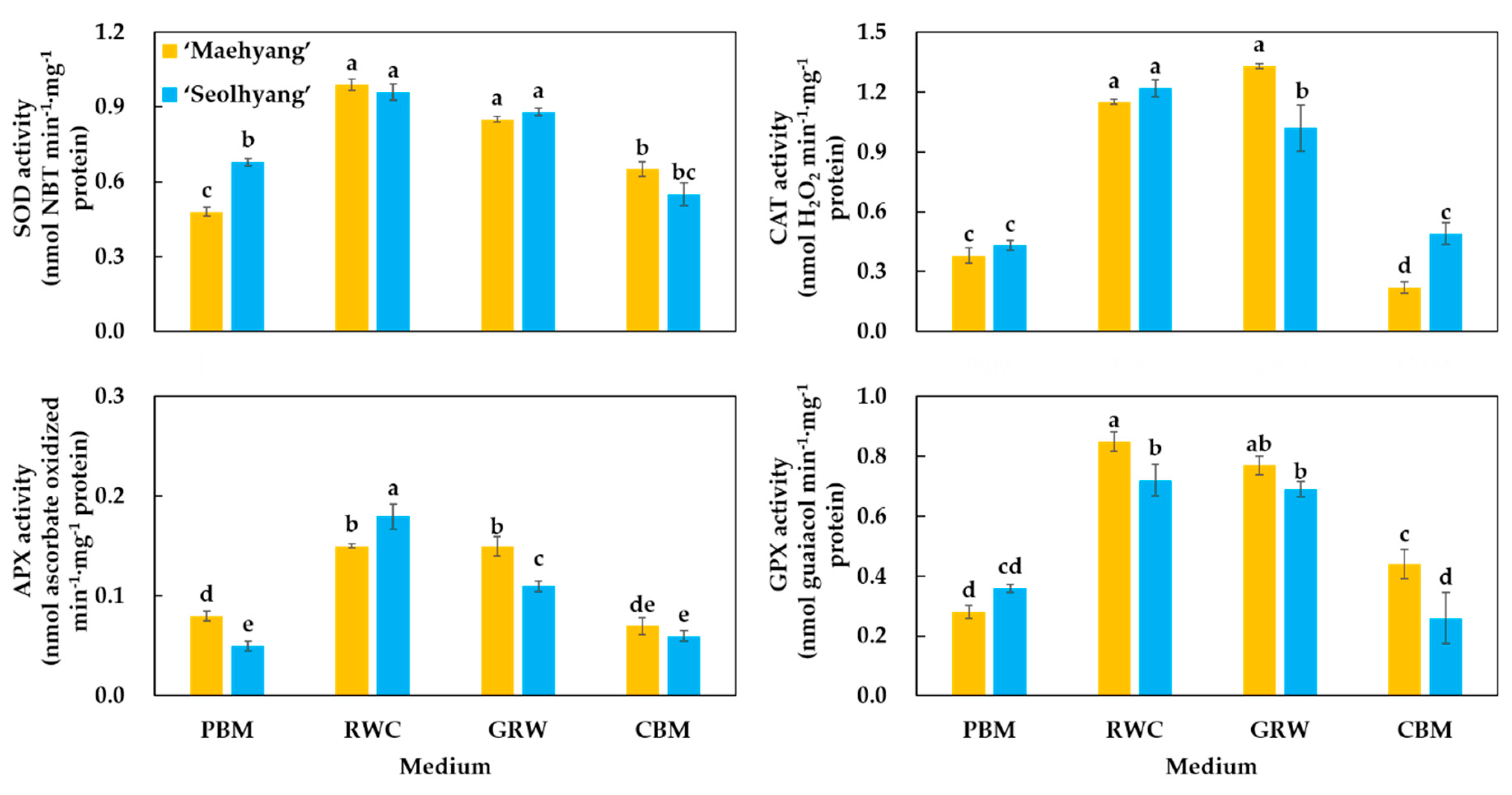
| Survival | |||||||
| F-test | C z | M | F | C * M | C * F | M * F | C * M * F |
| NS y | NS | *** | NS | NS | ** | NS | |
| Cultivar | Duration of Fogging (Day) | Rooting (%) | Ratio (%) of New Leaves | ||||||
|---|---|---|---|---|---|---|---|---|---|
| PBM | RWC | GRW | CBM | PBM | RWC | GRW | CBM | ||
| ‘Maehyang’ | 0 | 0.0 e z | 0.0 e | 0.0 e | 0.0 e | 0.0 e | 0.0 e | 0.0 e | 0.0 e |
| 3 | 86.6 b | 53.3 d | 66.7 cd | 73.3 c | 66.7 c | 40.0 d | 40.0 d | 53.3 c | |
| 6 | 100.0 a | 100.0 a | 100.0 a | 100.0 a | 40.0 d | 80.0 bc | 80.0 bc | 66.7 c | |
| 9 | 100.0 a | 100.0 a | 100.0 a | 100.0 a | 66.7 c | 53.3 c | 53.3 c | 66.7 c | |
| 12 | 100.0 a | 100.0 a | 100.0 a | 100.0 a | 80.0 bc | 80.0 bc | 80.0 bc | 80.0 bc | |
| ‘Seolhyang’ | 0 | 0.0 e | 0.0 e | 0.0 e | 0.0 e | 0.0 e | 0.0 e | 0.0 e | 0.0 e |
| 3 | 73.3 c | 53.3 d | 66.7 cd | 73.3 c | 26.7 d | 26.7 d | 33.3 d | 33.3 d | |
| 6 | 100.0 a | 100.0 a | 100.0 a | 100.0 a | 60.0 c | 53.3 c | 40.0 d | 80.0 bc | |
| 9 | 100.0 a | 100.0 a | 100.0 a | 100.0 a | 80.0 bc | 106.0 ab | 53.3 c | 73.3 c | |
| 12 | 100.0 a | 100.0 a | 100.0 a | 100.0 a | 86.7 bc | 80.0b c | 120.0 a | 106.0 ab | |
| Cultivar | Medium | Duration of Fogging (Day) | Shoot | Root | ||||||||||
|---|---|---|---|---|---|---|---|---|---|---|---|---|---|---|
| Length (cm) | Fresh Weight (g) | Dry Weight (g) | Length (cm) | Fresh Weight (g) | Dry weight (g) | |||||||||
| ‘Maehyang’ | PBM | 6 | 16.90 | e z | 5.17 | e | 1.26 | f | 5.05 | d | 1.84 | e | 0.35 | e |
| 9 | 18.07 | e | 7.21 | de | 1.63 | d | 7.92 | b | 2.31 | d | 0.43 | c | ||
| 12 | 23.83 | b | 11.93 | a | 2.70 | a | 9.69 | a | 4.31 | a | 0.73 | a | ||
| RWC | 6 | 22.80 | ab | 6.66 | e | 1.76 | c | 3.87 | e | 1.72 | e | 0.39 | d | |
| 9 | 20.03 | d | 8.27 | d | 1.86 | c | 6.81 | bc | 3.85 | b | 0.68 | a | ||
| 12 | 25.30 | a | 9.98 | c | 2.27 | b | 7.36 | bc | 2.17 | d | 0.41 | c | ||
| GRW | 6 | 18.43 | e | 5.81 | e | 1.40 | e | 4.52 | de | 1.88 | e | 0.37 | e | |
| 9 | 22.47 | c | 6.71 | e | 1.50 | e | 6.43 | c | 2.95 | cd | 0.50 | bc | ||
| 12 | 24.87 | ab | 10.69 | b | 1.82 | c | 7.72 | b | 3.00 | cd | 0.47 | bc | ||
| CBM | 6 | 18.87 | de | 6.69 | e | 1.61 | d | 6.64 | bc | 2.10 | de | 0.42 | c | |
| 9 | 21.93 | cd | 6.52 | e | 1.36 | f | 7.71 | b | 2.14 | d | 0.36 | e | ||
| 12 | 21.93 | cd | 8.77 | d | 1.67 | d | 9.18 | b | 3.20 | c | 0.52 | b | ||
| ‘Seolhyang’ | PBM | 6 | 22.97 | bc | 6.56 | c | 1.47 | d | 6.49 | bc | 2.42 | cd | 0.35 | d |
| 9 | 22.07 | bc | 5.69 | cd | 1.40 | d | 7.85 | b | 2.40 | cd | 0.41 | cd | ||
| 12 | 27.43 | a | 9.57 | a | 2.09 | a | 9.41 | ab | 4.01 | a | 0.62 | a | ||
| RWC | 6 | 19.77 | c | 3.83 | d | 1.38 | d | 3.39 | d | 1.42 | d | 0.41 | cd | |
| 9 | 23.20 | b | 8.07 | b | 1.88 | ab | 6.42 | c | 3.05 | c | 0.38 | d | ||
| 12 | 24.27 | b | 5.04 | cd | 1.78 | c | 3.45 | d | 1.87 | d | 0.34 | d | ||
| GRW | 6 | 23.93 | b | 7.01 | c | 1.82 | ab | 3.75 | d | 2.64 | c | 0.43 | cd | |
| 9 | 19.30 | d | 6.67 | c | 1.47 | d | 4.99 | cd | 2.50 | cd | 0.47 | c | ||
| 12 | 23.87 | b | 8.51 | b | 1.77 | c | 6.72 | bc | 3.03 | c | 0.47 | c | ||
| CBM | 6 | 17.33 | d | 3.89 | d | 1.41 | d | 4.70 | cd | 1.76 | d | 0.33 | d | |
| 9 | 21.03 | c | 8.21 | b | 1.73 | c | 10.07 | a | 3.60 | b | 0.56 | b | ||
| 12 | 24.37 | b | 8.28 | b | 1.81 | ab | 9.19 | ab | 3.50 | b | 0.55 | b | ||
© 2020 by the authors. Licensee MDPI, Basel, Switzerland. This article is an open access article distributed under the terms and conditions of the Creative Commons Attribution (CC BY) license (http://creativecommons.org/licenses/by/4.0/).
Share and Cite
Wei, H.; Liu, C.; Ryong Jeong, B. An Optimal Combination of the Propagation Medium and Fogging Duration Enhances the Survival, Rooting and Early Growth of Strawberry Daughter Plants. Agronomy 2020, 10, 557. https://doi.org/10.3390/agronomy10040557
Wei H, Liu C, Ryong Jeong B. An Optimal Combination of the Propagation Medium and Fogging Duration Enhances the Survival, Rooting and Early Growth of Strawberry Daughter Plants. Agronomy. 2020; 10(4):557. https://doi.org/10.3390/agronomy10040557
Chicago/Turabian StyleWei, Hao, Chen Liu, and Byoung Ryong Jeong. 2020. "An Optimal Combination of the Propagation Medium and Fogging Duration Enhances the Survival, Rooting and Early Growth of Strawberry Daughter Plants" Agronomy 10, no. 4: 557. https://doi.org/10.3390/agronomy10040557
APA StyleWei, H., Liu, C., & Ryong Jeong, B. (2020). An Optimal Combination of the Propagation Medium and Fogging Duration Enhances the Survival, Rooting and Early Growth of Strawberry Daughter Plants. Agronomy, 10(4), 557. https://doi.org/10.3390/agronomy10040557






